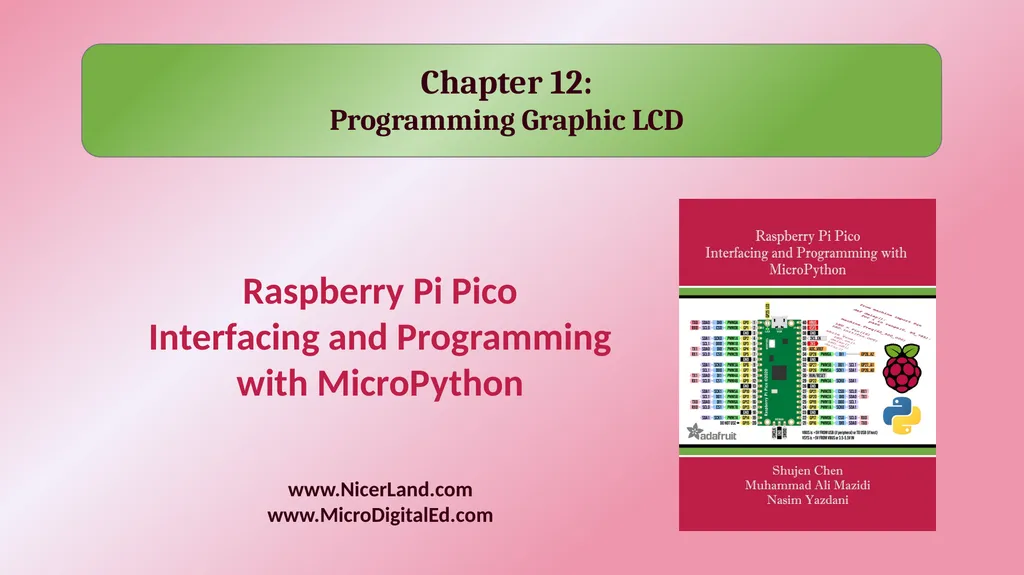Chapter 12: Programming Graphic LCD Raspberry Pi
Author : tawny-fly | Published Date : 2025-05-12
Description: Chapter 12 Programming Graphic LCD Raspberry Pi Pico Interfacing and Programming with MicroPython wwwNicerLandcom wwwMicroDigitalEdcom Figure 121 A picture on a Monocolor LCD Figure 122 A Zoomed Picture on a Monocolor LCD Figure
Presentation Embed Code
Download Presentation
Download
Presentation The PPT/PDF document
"Chapter 12: Programming Graphic LCD Raspberry Pi" is the property of its rightful owner.
Permission is granted to download and print the materials on this website for personal, non-commercial use only,
and to display it on your personal computer provided you do not modify the materials and that you retain all
copyright notices contained in the materials. By downloading content from our website, you accept the terms of
this agreement.
Transcript:Chapter 12: Programming Graphic LCD Raspberry Pi:
Chapter 12: Programming Graphic LCD Raspberry Pi Pico Interfacing and Programming with MicroPython www.NicerLand.com www.MicroDigitalEd.com Figure 12-1: A picture on a Mono-color LCD Figure 12-2: A Zoomed Picture on a Mono-color LCD Figure 12-3: Dot Pitch and Dot Size Figure 12-4: Mechanical specifications of a GDM12864 128x64 LCD Example 12-1 A manufacturer has advertised a 14-inch monitor of 1024 × 768 resolution with a dot pitch of 0.28. Calculate the diagonal size of the image on the screen. It must be less than 14 inches. Solution The calculation is as follows: (image diagonal size)2 = (number of horizontal pixels × dot pitch)2 + (number of vertical pixels × dot pitch)2 (diagonal size)2 = (1024 × 0.28 mm)2 + (768 × 0.28 mm)2 = 358.4 mm diagonal size (inches) = 358.4 mm × 0.039 inch per mm = 13.98 inches In the LCD the diagonal size of the image area is 13.98 inches while the diagonal size of the viewing area is 14 inches. Example 12-1 A manufacturer has advertised a 14-inch monitor of 1024 × 768 resolution with a dot pitch of 0.28. Calculate the diagonal size of the image on the screen. It must be less than 14 inches. Solution Figure 12-5: The Relationship between CPU and LCD Table 12-1: BPP (bit per pixel) vs. color Figure 12-6: Making New Light Colors by Mixing the 3 Primary Light Colors Table 12-2: The 16 Possible Colors Example 12-2 In a certain graphic LCD, a maximum of 256 colors can be displayed at one time. How many bits are set aside for the color of the pixels? Solution To display 256 colors at once, we must have 8 bits set for color since 28 = 256. Example 12-3 Find the frame buffer RAM needed for (a) 176x144 with 4 BPP and (b) 640x480 resolution with 256 colors. Solution (a) For this resolution, there are a total of 25,344 pixels (176 columns × 144 rows = 25,344). With 4 bits for the color of each pixel, we need a total of (25,344 × 4)/8= 16,672 bytes of frame buffer RAM. These 4 bits give rise to 16 colors. (b) For this resolution, there are a total of 640 × 480=307200 pixels. With 256 colors, we need 8 bits for the color of each pixel. Now, total of (640 × 480 × 8) / 8 = 307200 bytes of frame buffer RAM needed.














